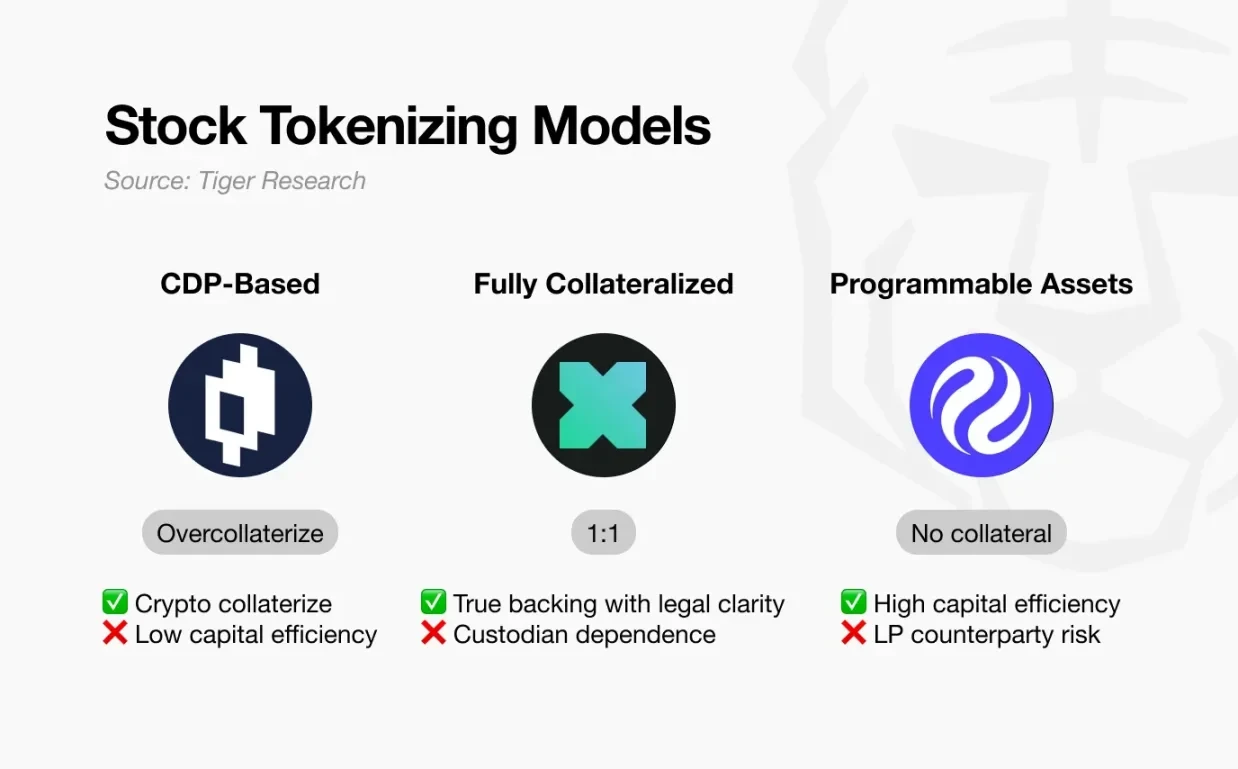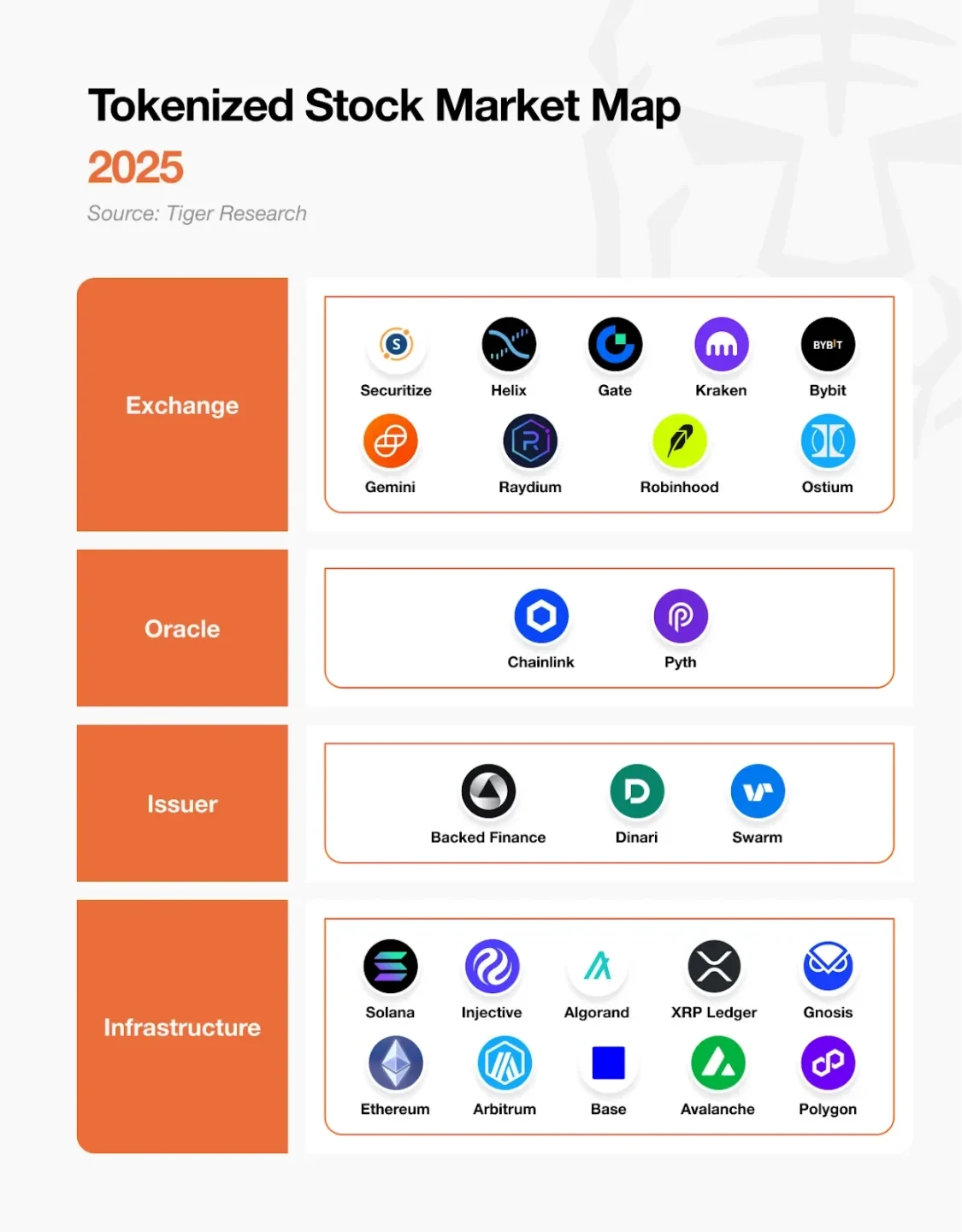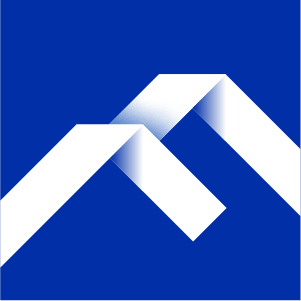The Tokenized Stock Market is Expected to Grow 2,600 Times, Who Will Benefit?
- 核心观点:代币化股票市场潜力巨大,2030年或达1.34万亿美元。
- 关键要素:
- 全球股票1%代币化即达万亿规模。
- 2025年监管明确性成关键转折点。
- DeFi整合提供额外收益功能。
- 市场影响:加速传统金融与加密行业融合。
- 时效性标注:长期影响。
Original author: Tiger Research
Original translation: AididiaoJP, Foresight News
summary
Market Opportunity: The tokenized stock market is currently worth $500 million, but if 1% of the global stock market can be tokenized, the market size could reach $1.34 trillion by 2030. This represents a potential growth of 2,680 times, driven primarily by regulatory clarity and mature infrastructure by 2025.
Value Proposition: Tokenized stocks support 24/7 global trading and allow tokenized stock ownership. Its key differentiation lies in the integration with decentralized finance (DeFi), allowing investors to use their stocks as collateral for lending and earning returns without selling them.
Why it works: Unlike other real-world assets (RWAs) that require creating demand from scratch, tokenized stocks directly tap into the $134 trillion global stock market and target clear pain points. The combination of existing demand and solvable pain points makes it the RWA category with the greatest potential for mass adoption.
The integration of the crypto industry and traditional finance: Blurred boundaries
Traditional finance and the crypto industry are moving closer to each other.
On the one hand, institutions such as Citigroup and Bank of America are preparing to issue stablecoins. On the other hand, projects such as Injective and Backed Finance are tokenizing stocks such as Apple and Tesla and putting them on the blockchain.
As traditional institutions adopt crypto and Web 3 projects tokenize stocks, the border between the two industries is disappearing.
This convergence accelerated after Crypto Week in the U.S., a period of regulatory activity focused on digital assets, and the passage of the GENIUS Act, which brought stablecoins into the federal regulatory framework. Wall Street and DeFi are no longer in competition, but increasingly complementary.
Traditional finance has a clear incentive to integrate crypto. In addition to the potential for innovation, the crypto market has proven its profitability, and traditional financial brands can provide the trust that the crypto industry currently lacks. But the reverse logic, why crypto platforms would tokenize stocks, is less obvious. The market is still in its early stages, and motivations are varied and speculative.
This report explores this question by analyzing the structure of the tokenized equity market and its key players.
What is a tokenized stock market?
The tokenized stock market refers to the conversion of traditional stocks into digital tokens on the blockchain. These tokens are designed to reflect the value of the underlying shares, but usually do not come with shareholder rights. Most tokenized stocks exist in the form of derivatives rather than directly holding stocks.

While the first wave of tokenized stocks emerged in 2021, most early models (such as Mirror Protocol) failed to scale due to inefficiencies and systemic risks (especially in ecosystems such as Terra). Recent approaches have introduced improved mechanisms with stronger capital dynamics and compliance frameworks, represented by Injective and xStocks.
The interest in tokenized stocks has grown dramatically with the rise of the RWA (real world asset) trend, which has become a key narrative in the crypto market.
Beyond these immediate advantages, tokenized shares enable new use cases through composability. Since they exist outside of traditional regulatory frameworks, they can be used as collateral in lending protocols or generate yield in DeFi applications.
For example, if an investor in Indonesia wants to gain exposure to Tesla shares, the traditional way requires opening a foreign brokerage account, filling out paperwork, and paying currency conversion fees, and can only operate during limited trading hours. With tokenized shares, the same investor can instantly purchase Tesla tokens through a smartphone and deploy them in DeFi protocols for lending, providing liquidity, or generating income.
Possible scenario: Tokenization of 1% of global stocks

The tokenized stock market is still in its early stages. According to rwa.xyz, the current market size is approximately $500 million. This is only 0.0004% of the $134 trillion global stock market. However, if only 1% of global stocks were tokenized in the next decade, the market could grow to $1.34 trillion, 2,680 times its current size.
The turning point in 2025
The second half of 2025 could be a critical turning point. Although still in its early stages, tokenized stock trading volume within the Solana ecosystem surged from $15 million to $100 million in one month, a 566% increase.
More important is the entry of regulated players. Major fintech companies are expanding tokenization services globally, and Robinhood announced the launch of related operations in Europe. As the market expands from North America to Europe and Asia, regulatory clarity will be a catalyst. In particular, once stock tokenization is launched under the EU's MiCA framework, the market is expected to expand rapidly.
Conditions for success in 2030
Achieving the goal of tokenizing 1% of the global stock market by 2030 requires a clear rationale. Investors must have a strong incentive to move from traditional systems to tokenized platforms. This shift will only happen if four key conditions come together.
First, cost savings must be demonstrated.
In theory, brokerage, settlement and management fees can be reduced by 50%-70%, which needs to be verified in practice. If tokenization can significantly reduce foreign exchange and cross-border transaction costs, it will provide a strong alternative for global investors.
Second, the practicality of round-the-clock trading needs to be verified.
Tokenized stocks should support continuous trading in Asian, European, and U.S. markets. By eliminating the time constraints of traditional exchanges, they can provide greater liquidity and respond to global events in real time, thereby improving overall trading efficiency.
Third, DeFi-based secondary income generation must become a core function.
Tokenized stocks should not only be tradable assets, but also become a fundamental component of DeFi protocols. If investors can use them for collateralized lending, AMM-based options, liquidity provision, and automated portfolio strategies, they can earn additional returns without selling. As these mechanisms mature, they will strengthen the main advantages of tokenization. Cost efficiency, accessibility, and continuous trading make it increasingly attractive to break away from traditional systems.
Key players in the tokenized stock market

The tokenized stock market is built on four core layers that work in harmony.
At the bottom is the infrastructure layer, which provides the blockchain network on which all transactions take place. Above it are the issuers, who are responsible for creating tokenized representations of traditional stocks. To ensure accurate price tracking, oracles provide real-time market data and maintain links to the underlying assets. Finally, exchanges allow investors to buy and sell tokenized stocks.
A fully functioning tokenized equity ecosystem requires all four layers. Without any one layer, the system will lack the necessary components for secure issuance, pricing, and trading.
Tokenization in practice
Let’s say an investor wants to gain exposure to Apple ($AAPL) stock in a tokenized form. They can trade iAAPL with up to 25x leverage on Helix, purchase $xAAPL spot tokens issued by Backed Finance on Kraken, or get 24/7 access to US stocks through Robinhood EU as a European resident. Each exchange operates in a different regulatory environment and trading model, catering to different investor needs.
In order for tokenized stocks to accurately reflect real stock prices, reliable market data is essential. For example, Chainlink obtains the real-time price of Apple stock from Nasdaq and uploads it to the chain. It also provides proof of reserves, verifying that each token is backed by the corresponding Apple stock at a 1:1 ratio. This ensures that investors can trust the price integrity of the token.
The issuer converts traditional stocks into tokenized assets. Backed Finance holds actual Apple stocks in Swiss banks and issues $xAAPL tokens at a 1:1 ratio. In contrast, Injective's $iAAPL uses iAssets without holding the underlying stocks, synthetically tracking prices through oracle data, and enabling leveraged trading without physical settlement. These two methods represent different paths to connect traditional stocks with blockchain infrastructure.
All transactions and token transfers are conducted on the blockchain network. On Solana, Backed Finance’s xStocks trades with low latency and minimal fees. Injective supports high-performance order book-based trading. On Ethereum and Arbitrum, Dinari’s dShares operates under US regulatory compliance. Each chain offers different technical capabilities to meet the infrastructure needs of tokenized stock platforms.
Major players in the tokenized stock market
Key players in the tokenized stock market shape the ecosystem based on different strategies and capabilities. Here is a summary of the main companies and their current positioning:
Injective: A leader in tokenized equity perpetual contracts. Cumulative trading volume exceeds $1 billion by the first half of 2025. Through its Helix DEX, it provides up to 25x leverage, driving liquidity in the derivatives space.
xStocks (Backed Finance): 80% of the top 10 tokenized stocks by market cap. Uses a 1:1 backing model, with stocks held in custody at Swiss banks and widely adopted in the Solana ecosystem.
Robinhood: Expanding to Europe in 2025, offering over 200 tokenized US and private stocks. Providing zero-fee trading on Arbitrum, with 24/5 trading support.
Gemini: Partnering with Dinari Global to offer more than 60 tokenized stocks to EU investors. Compliant with MiFID II, providing services within the European regulatory framework.
Securitize: A leader in tokenizing real-world assets, including U.S. Treasury tokens like $BUDIL. Also offers equity tokenization products totaling $312 million, with the largest single asset deployed on Algorand.
Chainlink: Provides critical data infrastructure, including real-time stock and ETF price feeds, and proof-of-reserve verification of asset backing.
The role of tokenized shares in the RWA market
Limited but most viable market segments
Tokenized shares are just one niche in the broader real-world asset (RWA) market. Without regulatory clarity, adoption will be limited. However, this barrier has begun to loosen. Robinhood has announced tokenized shares services in Europe, and other major platforms are following suit. As more jurisdictions align with these developments, regulatory acceptance is likely to expand.
Validated needs and clear pain points
The strength of this market lies in its fundamentals. Stocks are already widely traded assets with a clear demand. At the same time, the trading process has long been plagued by inefficiencies, especially in terms of access, settlement speed, and geographic restrictions. The combination of proven demand and solvable pain points makes stocks an ideal starting point for tokenization.
Unlike other RWA categories that need to generate demand first, tokenized equities build directly on the $134 trillion global equity base. The case for tokenization is strengthened by its tangible advantages: lower costs, wider access, 24/7 trading, and DeFi integration. As regulatory frameworks mature, these advantages will drive accelerated adoption of tokenized equities.



